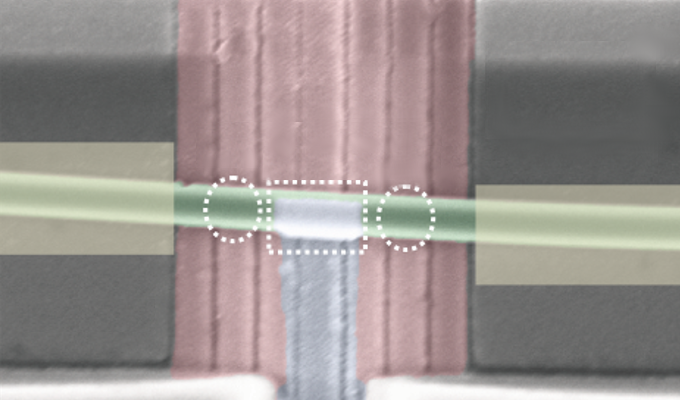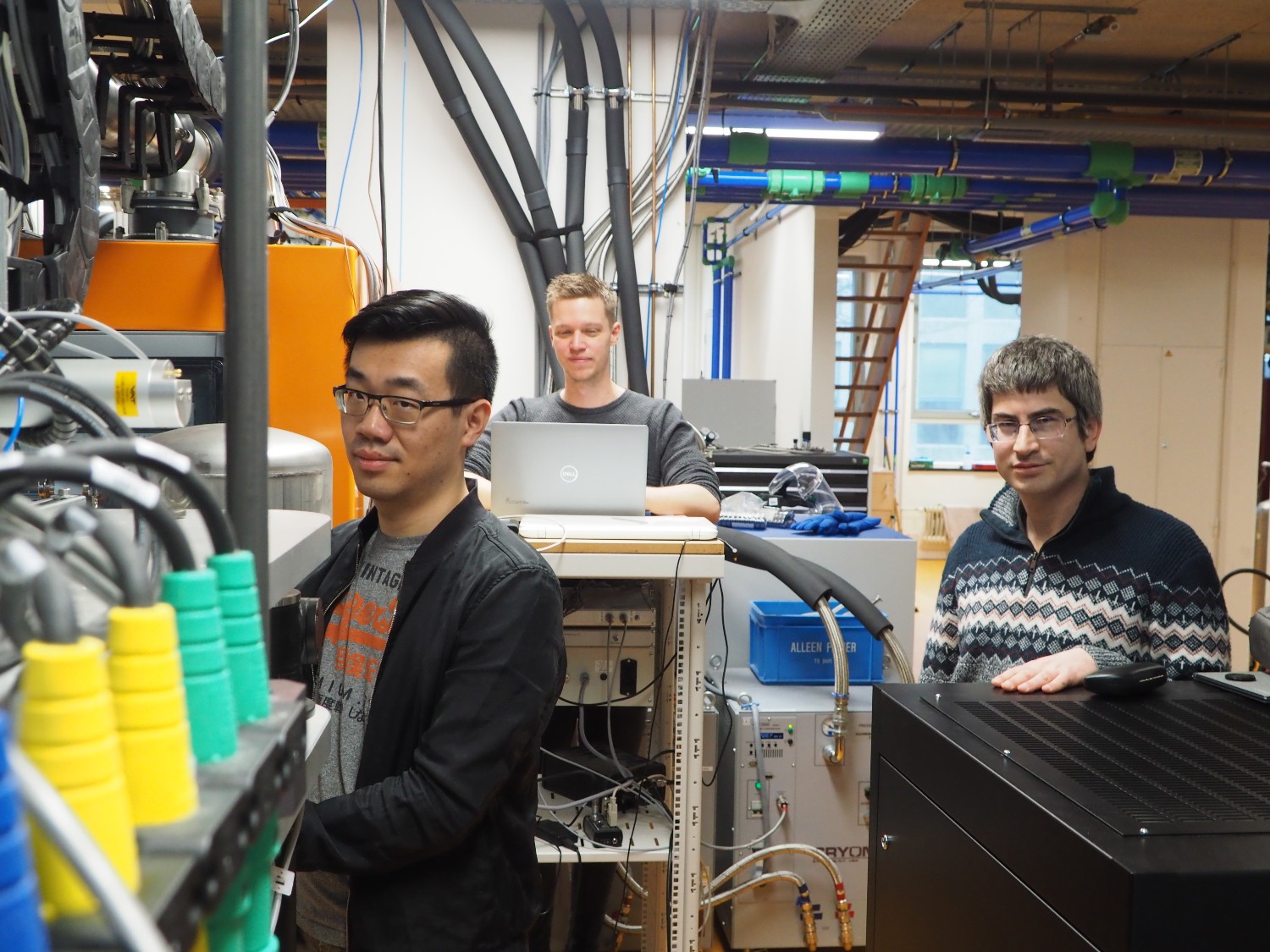After the withdrawal of two Majorana articles, the research field was in crisis, says Tom Dvir. He is first author of a new QuTech publication. What has changed?
Guanzhong Wang, Nick van Loo and Tom Dvir (left to right) have resumed Majorana research in the QuTech labso. (Photo: Jos Wassink)
It was always difficult to imagine Majoranas. They popped up in 2012 in Professor Leo Kouwenhoven’s (Faculty of Applied Sciences) laboratory at TU Delft. There was talk of a particle that would be its own counter-particle and that always occurs in pairs. It was all very ambiguous. Sometimes people talked about an elementary particle that had already been predicted in 1927 (by Italian physicist Ettore Majorana), and sometimes a Majorana was presented as an ‘exotic quantum state’. Regardless of the differences in description, everyone agreed on the most important characteristic of Majoranas: stability. That quality seemed to make them ideally suited for building qubits (quantum bits) – the building blocks of quantum computers.
‘We hope to refocus our efforts’
In 2018, QuTech put the flag out – this TU Delft private-public research institute had housed all quantum computing research since 2013. Six years after the first sightings, researchers had succeeded in definitively demonstrating the existence of Majoranas, they wrote in Nature. This opened the door to the production of Majorana qubits.
Two years later, however, QuTech researchers were forced to retract the celebrated Nature article because errors had been discovered in the treatment of the measurement data. Confidence in the dim elementary particles evaporated faster than spilled nitrogen on the laboratory floor. A second retraction followed, an integrity investigation was launched, and Leo Kouwenhoven resigned as Director of the Microsoft Quantum Lab. The Majorana’s house of cards had collapsed (check references below).
Back to basics
Just under three years later, a new Majorana article in Nature has now emerged from the ruins: Realisation of a minimal Kitaev chain in coupled quantum dots. We recognise two of the authors from the retracted articles: Guanzhong Wang and Leo Kouwenhoven.
“After the retraction, the research field was in crisis,” says Tom Dvir, the first author of the new article. “We hope our new invention will help refocus our efforts.”
What is so new about this invention? Perhaps the initial construction with a nanowire on a chip contacting a superconductor was too complicated, Dvir and Wang thought. Maybe that’s why they didn’t manage to repeat the measurements. So they decided to fall back on simplest conceivable construction for hosting Majoranas: a semiconductor nanowire 100 nanometres thick with a small piece of aluminium coating over it as a superconductor. Electrodes under the nanowire isolate pieces of the wire from the rest. These then become quantum dots – artificial nanostructures with quantum properties.


The Majoranas’ house consists of two quantum dots (circled) connected by a superconductor (grey plane) on a nanowire (green horizontal). (Photo: Tom Dvir/QuTech)
‘We need to be able to manipulate Majoranas’
With the minimal Kitaev chain in the cryostat, the right voltage on the electrodes (‘gates’), and the magnetic field switched on, Majoranas can now be reliably generated, the TU Delft researchers show. In the lab, Wang points out the Majoranas as white spots on the computer screen.
They may be Majoranas, but they are the Ladas of the genre. That’s because Majoranas owe their stability to the spacing that protects them from local thermal and electrical disturbances. But these Majoranas sit close together and are therefore less protected from disturbances.
What’s next?
Getting from these poor man’s Majoranas (article in Physics) to a functional qubit still requires a lot of research. “Let’s be clear: a qubit needs at least four Majoranas and preferably six. In addition, Majoranas are sought after for their stability, but in this case they are not stable. The way to make them more stable is to make longer chains. So we have to lengthen the chains AND we have to make more of them,” says Wang.
Dvir says he is already working on an extended Kitaev chain with three quantum dots instead of two, but there may have to be twice as many, including all the associated control systems. There is still a lot of work to be done there.
“And if we want to work with a chain, it’s not enough to generate Majoranas, we also need to be able to manipulate Majoranas,” Wang explains. But that’s what researchers were saying a decade ago, right? “Exactly,” says Wang. “That was the Holy Grail then. And it still is now.”
‘We did not experience any bias ‘
Leo Kouwenhoven wasn’t available for comments. He is listed as the last author on the new Nature publication. Was that not a risk given the prior history? “Kouwenhoven is the principal investigator in this lab,” Wang replies. “It would not be ethical to omit his name. We did not experience any bias either. The only questions were about the scientific content, and they were all fair questions.”
A spokesperson for Nature responded to Delta‘s question about confidence in the authors, ‘For reasons of confidentiality, we do not comment on the editorial history or the review process of specific papers published in the journal. All submitted manuscripts are independently reviewed based on the quality and timeliness of their science. We apply the same editorial principles to every submission we receive.’
- References:
In 2012 Delta wrote about the discovery of Majoranas and how they could be used as qubits. In 2018, we reported on what was then considered a definitive breakthrough. TU Delft issued an epic press release about it. Two years later, Delta wrote about the research group’s doubts and QuTech announced that incorrect data processing had taken place. Two official retractions of Nature articles followed in 2021. The first on the Majorana measurements, the second on the materials used. The following year, Kouwenhoven left Microsoft. A few months later, the LOWI integrity committee ruled that Kouwenhoven and his postdoc Hao Zhang had been negligent. - Update:
13 March 2023 – Co-author Michael Wimmer reports that the peer-review report is public and accessible via a link on the Nature website.
Do you have a question or comment about this article?
j.w.wassink@tudelft.nl


Comments are closed.